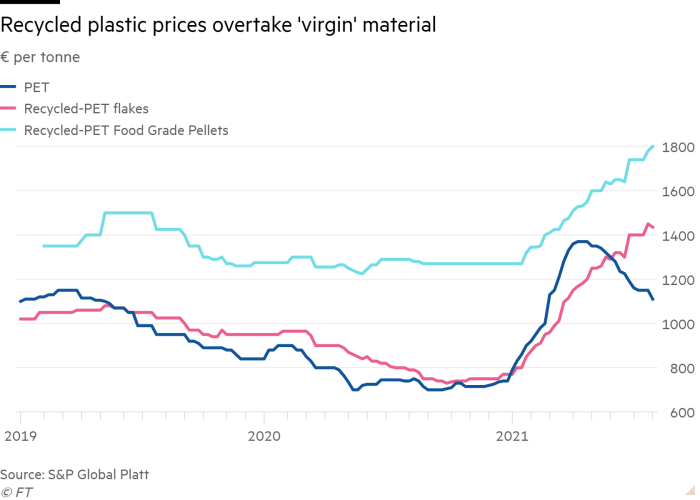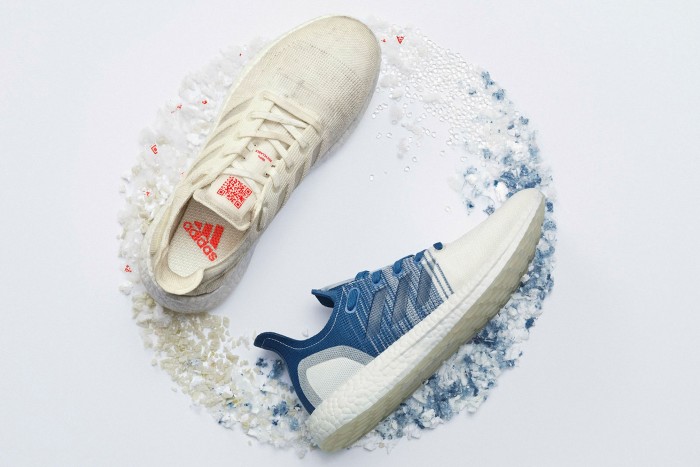If you have browsed the internet for a new swimsuit this summer, you might have come across the latest sustainable fashion trend — bikinis and trunks made from plastic bottles, ostensibly diverted from the ocean.
Across US and UK online retailers, swim-and activewear described as containing recycled synthetics more than doubled in volume in the year to June compared to 2020, according to retail intelligence platform Edited.
Plastic waste has infiltrated virtually every sector. Sneaker brands, from Nike and Adidas to ‘sustainable’ labels such as Veja and Greats, rely on it for their green credentials.
Couture designers have created outlandish plastic looks to make a statement on the runway. Japanese designer Tomo Koizumi this year showed voluminous recycled plastic organza dresses in bubblegum pink, yellow and blue. In 2019, Prada re-released its iconic 90s nylon bag as a recycled version.
You can even purchase all of this with an Amex credit card made from plastic waste.
The boom arguably began about 15 years ago. The American manufacturer Unifi launched a recycled polyester fibre in 2007, with outdoor clothing companies Patagonia and Polartec among its first customers for fleece outerwear that became a finance industry meme.
The fibre now makes up nearly 40 per cent of its sales revenue and some 800 brands incorporate it. The remainder of Unifi’s products are so-called virgin synthetics.
The switch to recycled polyester is an efficient choice in terms of its immediate environmental impact. It produces roughly 70 per cent fewer greenhouse gas emissions than virgin polyester, according to industry non-profit group Textile Exchange.
“If a brand is trying to have a larger impact in their emission reductions particularly, recycled feedstocks is a great option. Because they can start small and scale it up,” said Siena Shepard, climate strategy manager at Textile Exchange.
Like most sustainability trends, this one comes with a catch: your recycled plastic swimsuit is most likely to end up in landfill or back in the sea as washing results in microplastics going into the water system.
But the more immediate issue for fashion brands is the rising cost of recycled plastic.
The same plastic required for making clothing — recycled polyethylene terephthalate plastic, or rPET — already has a voracious market: recycled consumer goods packaging.
And supply is tight, in part thanks to the world’s woeful recycling capacity.
Globally, plastic recycling rates are estimated to be between 14-18 per cent, according to the OECD. In the US, only 30 per cent of PET bottles are recycled, according to the US Environmental Protection Agency.
“The increasing use of recycled polyester in recent years has made the sourcing costs increasingly competitive compared to virgin polyester,” said Adidas, which has switched an impressive 60 per cent of its polyester for recycled stock.

Until 2019, the price of rPET used to make recycled polyester was €1,050 per tonne, or about €200 cheaper than virgin PET. Now the price has jumped to €1,435. More expensive, often transparent, food grade rPET used for packaging of consumable items costs €1,800 per tonne.
For fast fashion groups whose USP is to produce clothing as cheaply and quickly as possible, paying the extra cents for recycled polyester starts to add up, affecting the margin on a $5 T-shirt.
In a survey of the growing UK-based groups, Asos, Boohoo, its PrettyLittleThing subsidiary, and Missguided, recycled synthetics were found in just 3 per cent of products, according to the Royal Society for Arts, Manufactures and Commerce.
H&M, the world’s second largest fashion retailer and owner of the Cos, Arket, & Other Stories and Weekday brands, has pledged to use 100 per cent recycled and sustainably sourced materials by 2030. The group said just 5.8 per cent of its goods presently contain recycled material.
“We aim to increase our use of recycled polyester every year,” H&M said. “Even though we always set ourselves ambitious goals, we do this based on the expertise within our own sustainability teams as well as our various partners, which makes our goals equally as ambitious as realistic.”

“The overarching reason is simply a build-up of voluntary commitments, sustainability targets and legislation, and there’s not enough supply in Europe for everyone to do that,” said Ben Brooks, recycled plastics lead at S&P Global Platts.
New taxes on virgin PET are likely to push demand for rPET up even further.
This year the EU introduced a tax on virgin plastic packaging and the UK will levy packaging that does not contain 30 per cent recycled content by April 2022.
Some fibre manufacturers and plastics giants are starting to acquire their own recycling capacity in response.
The world’s largest PET producer, Indorama Ventures, received a $300m loan from the International Finance Corporation to help it expand its PET bottle recycling capacity to 750,000 metric tons a year by 2025.
Another major PET producer, DAK Americas, acquired an rPET facility in the US in 2019. Chemicals group Dow has partnered with recycling firm Mura Technology to source rPET from a new facility in Teeside in the UK.
The industry forerunner, Unifi, also owns a PET bottle recycling facility in North Carolina, where it is based. “To increase the supply of this waste, we need consumers, businesses and governments to work together to increase recycling rates,” said Jay Hertwig, vice-president of commercialisation.
Even if fashion brands fulfil their recycled content targets, and the world ups its recycling capacity, there is another looming long-term problem: recycled polyester is not itself mechanically recyclable. Just like most virgin plastics, it will probably end up in landfill.
The only way to achieve circular textile-to-textile recycling at scale is through chemical recycling, a process in which plastic waste is broken down into chemicals or oils, providing raw material for future plastics.
Petrochemical companies such as Shell, Dow and Indorama are all investing in chemical recycling technology. Several start-ups, such as Worn Again, specialise in textile-to-textile chemical recycling.
“Longer term the solution for plastics recycling and specifically polyester clothing is going to be chemical recycling,” said Rob Stier, lead petrochemical analyst at S&P Global Platts.
However, “[these] are years away from large commercial operations, they’re probably going to have a pretty bad carbon footprint and be expensive,” Stiers adds. “So yes it will meet the demand, but at what cost?”


